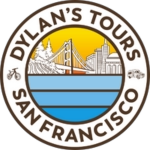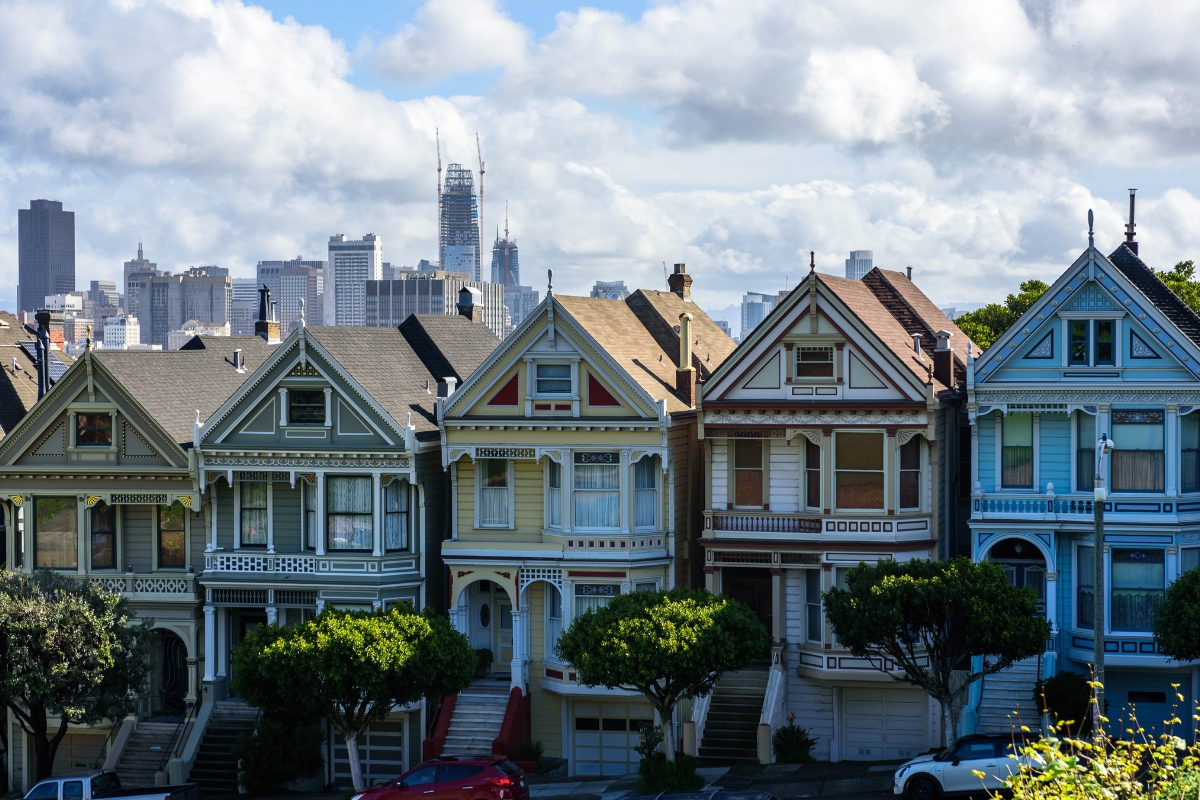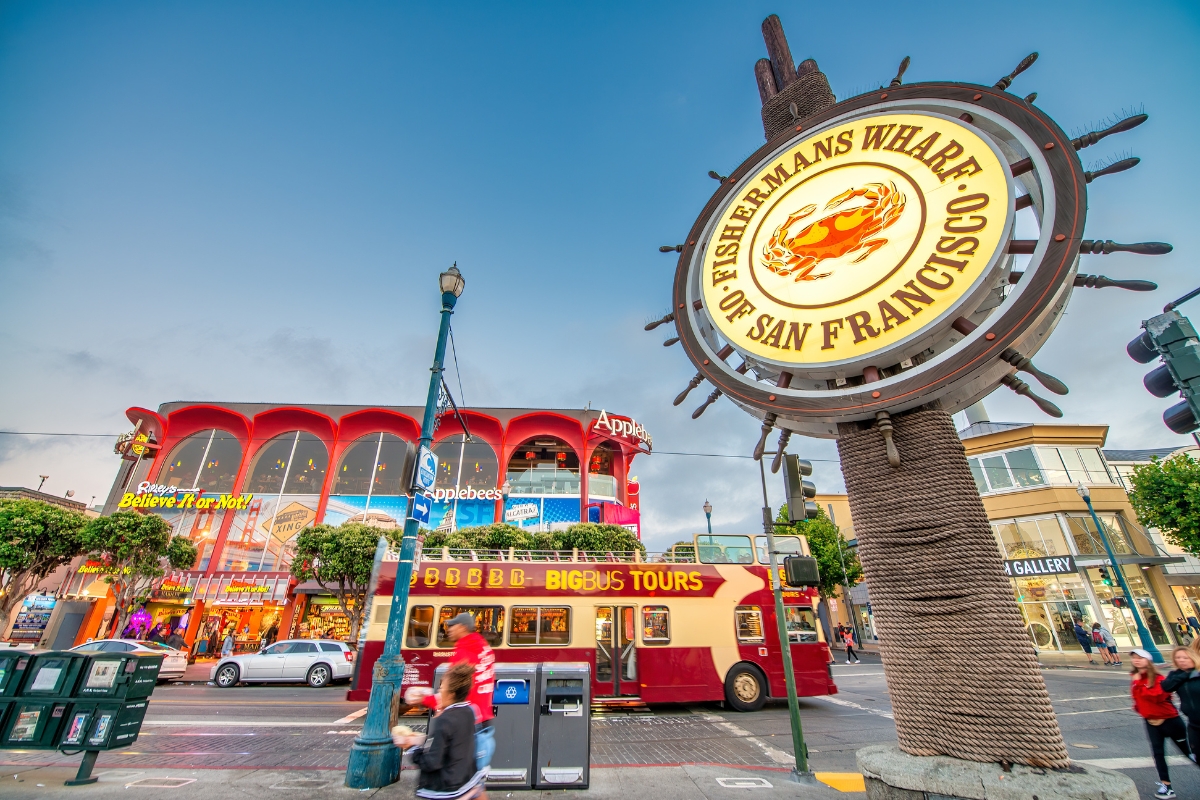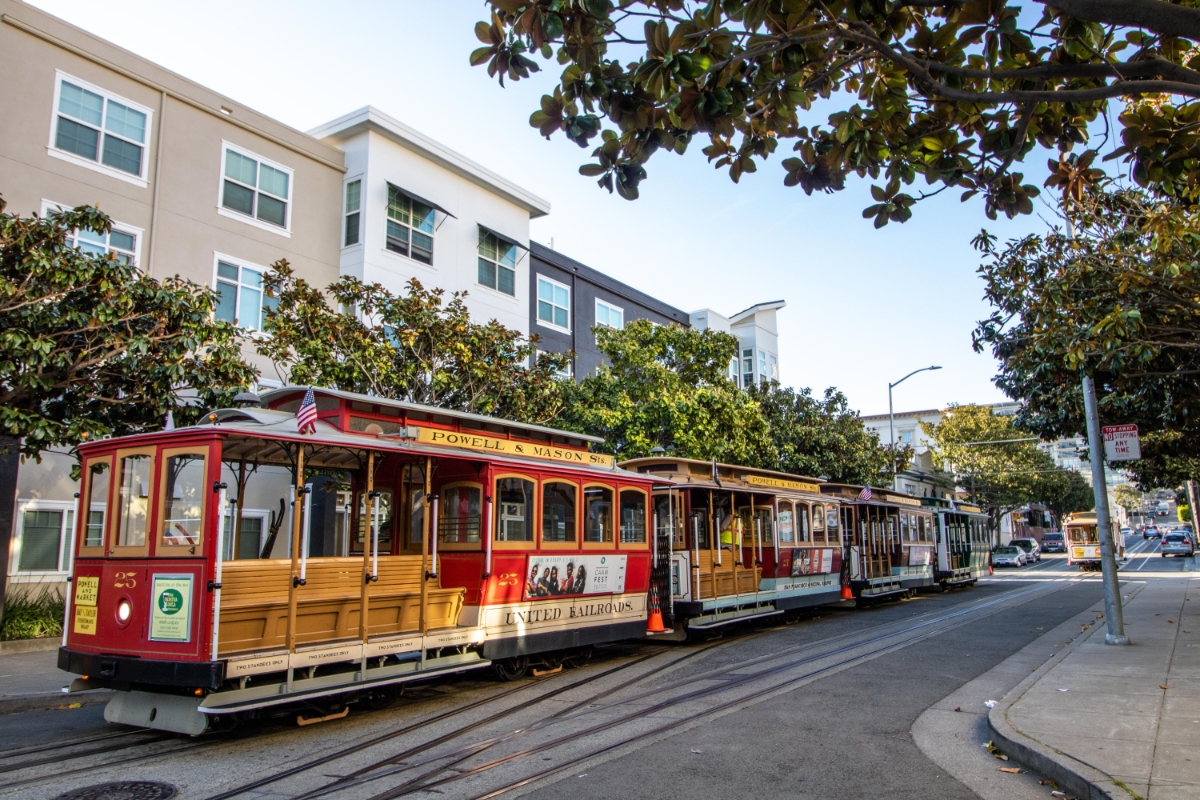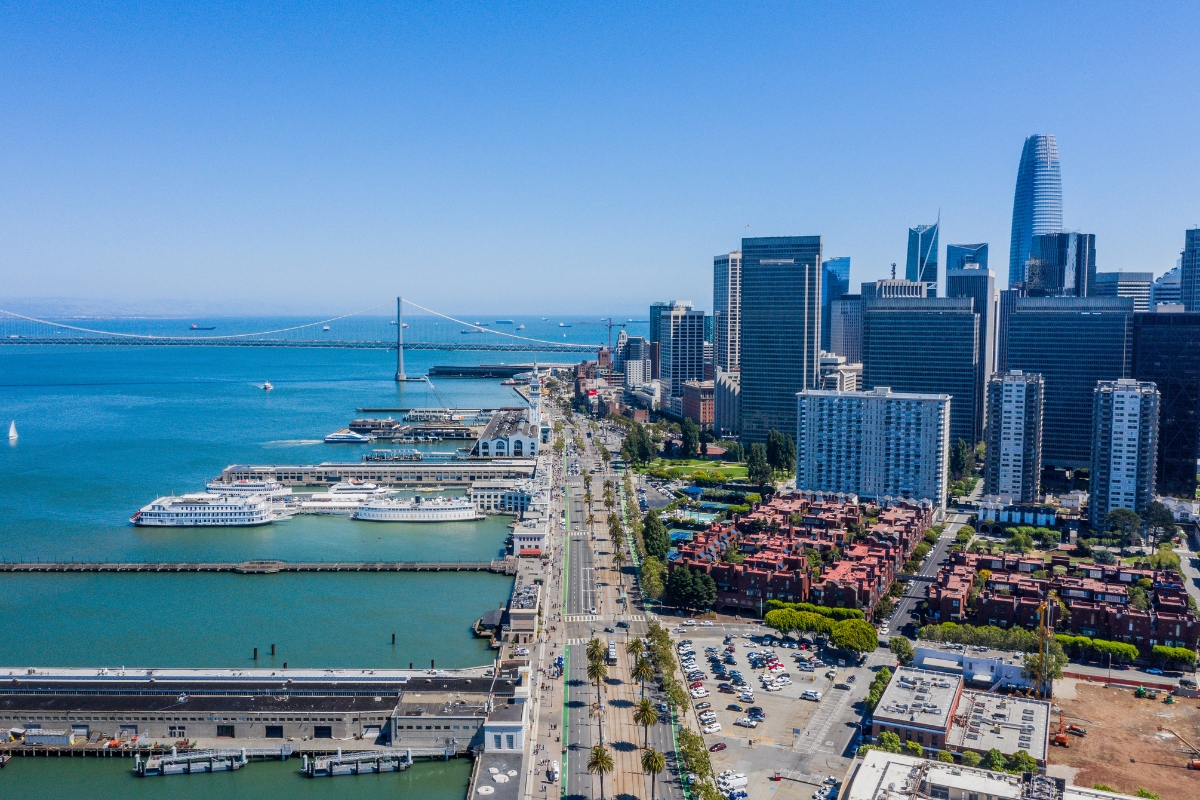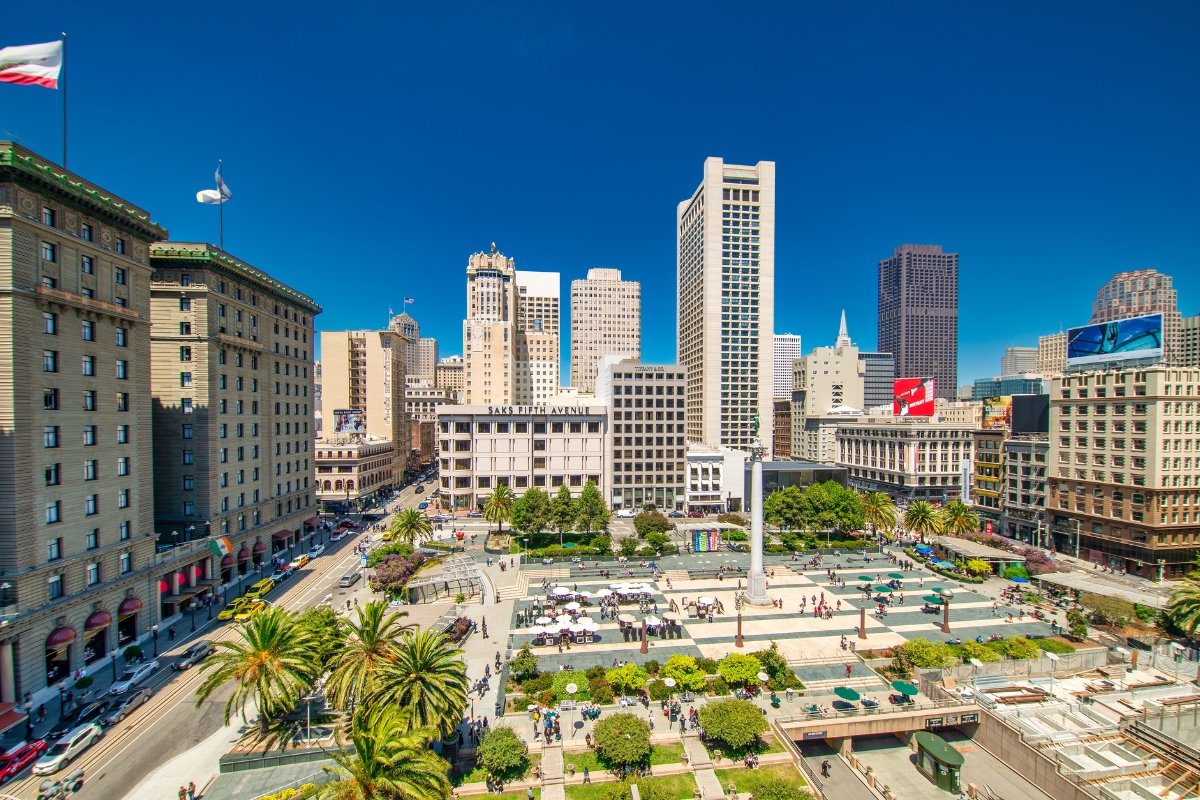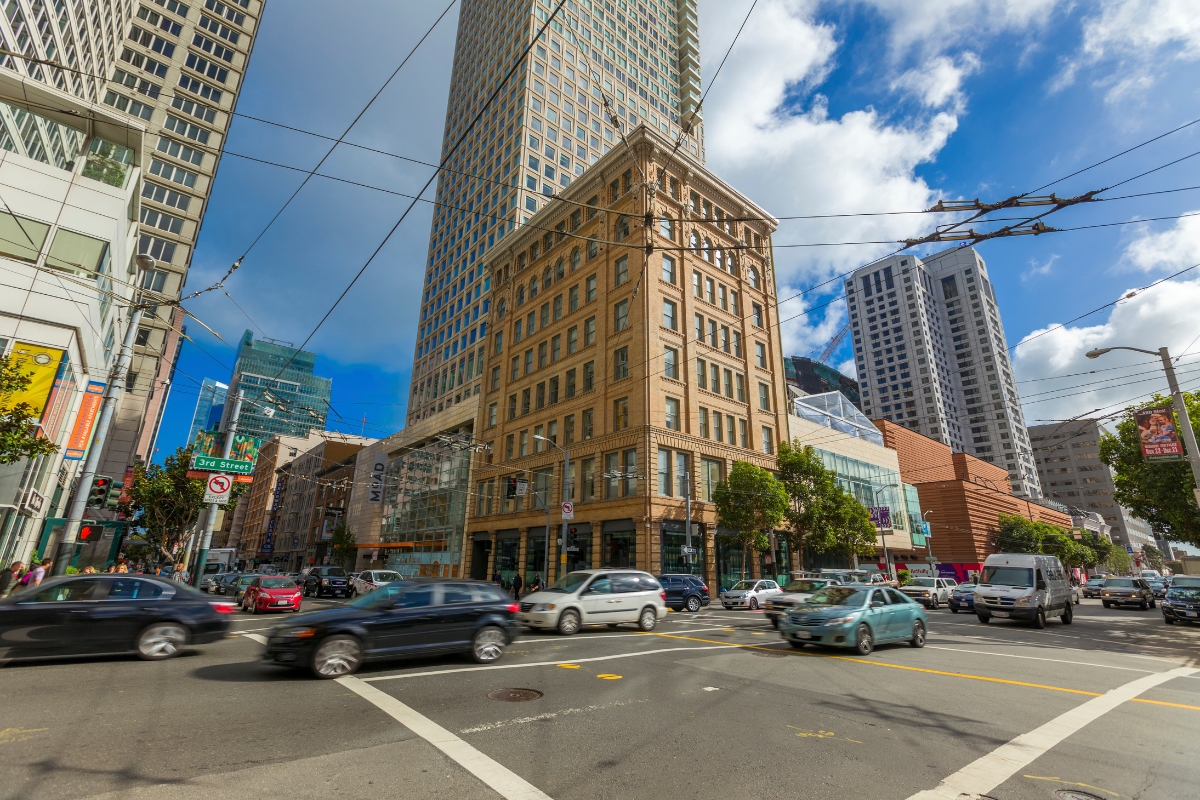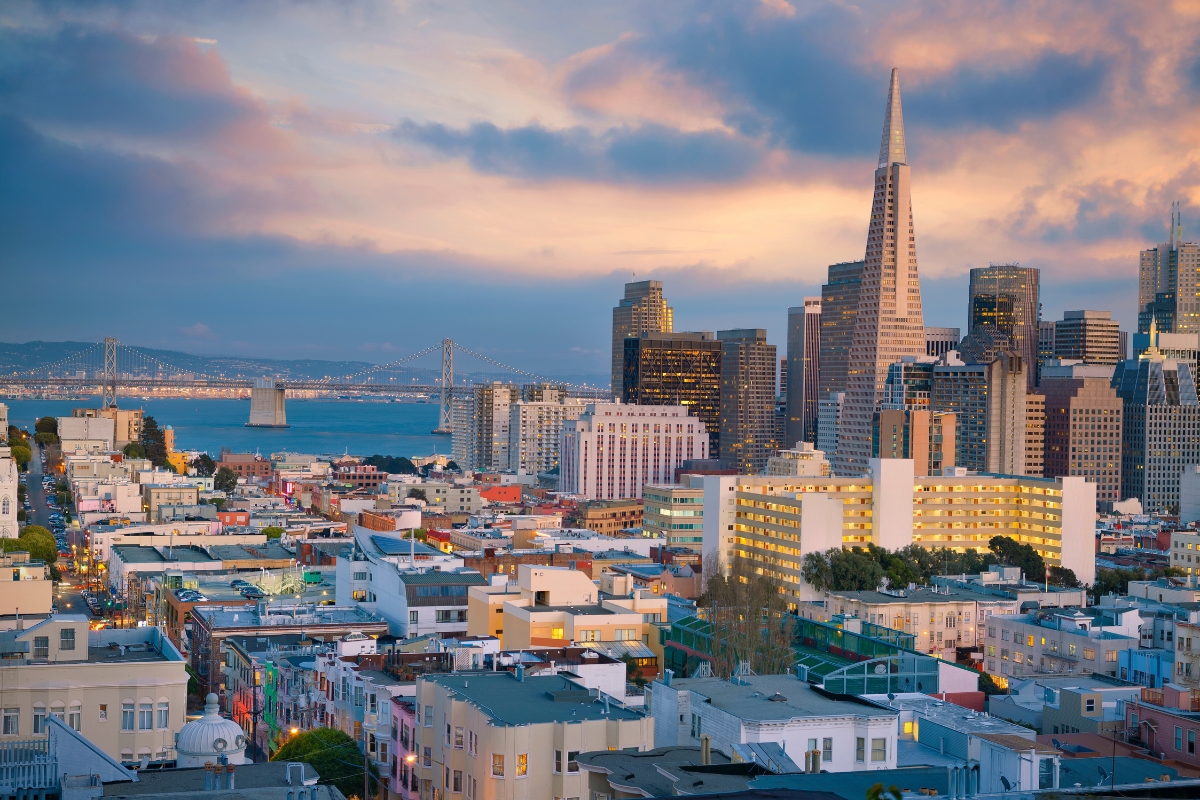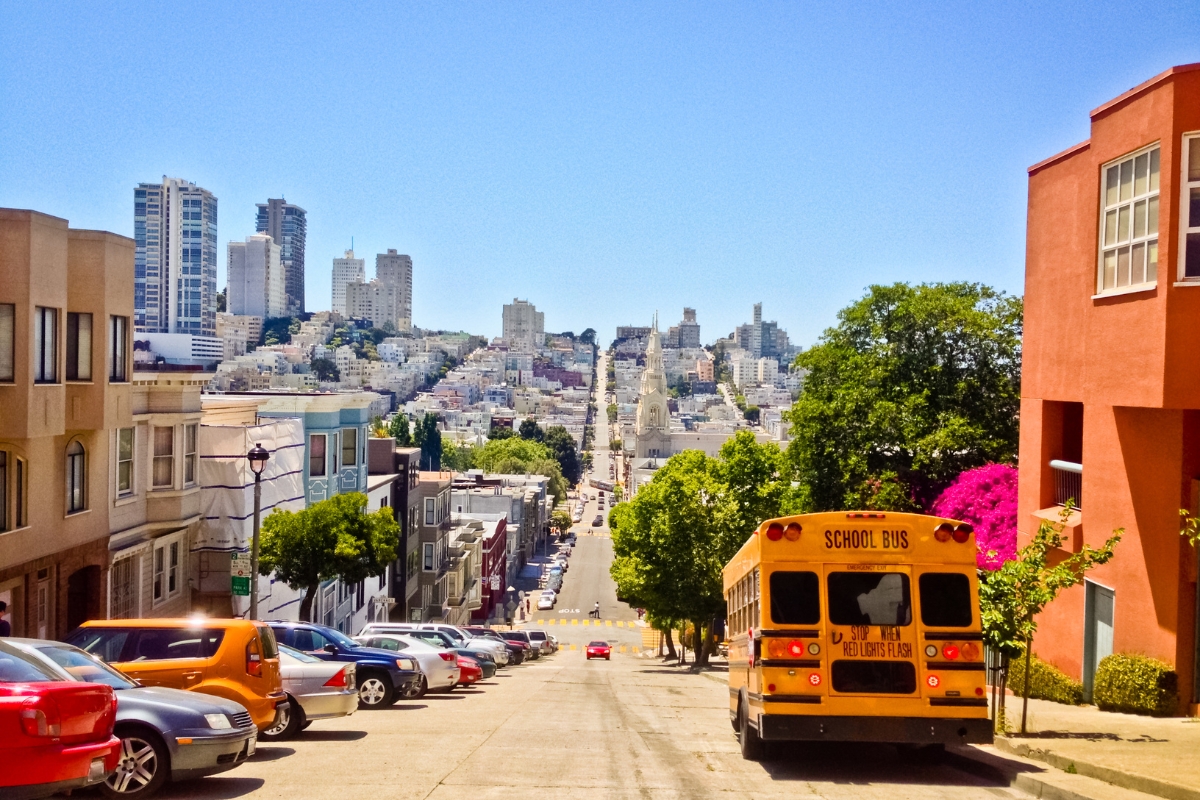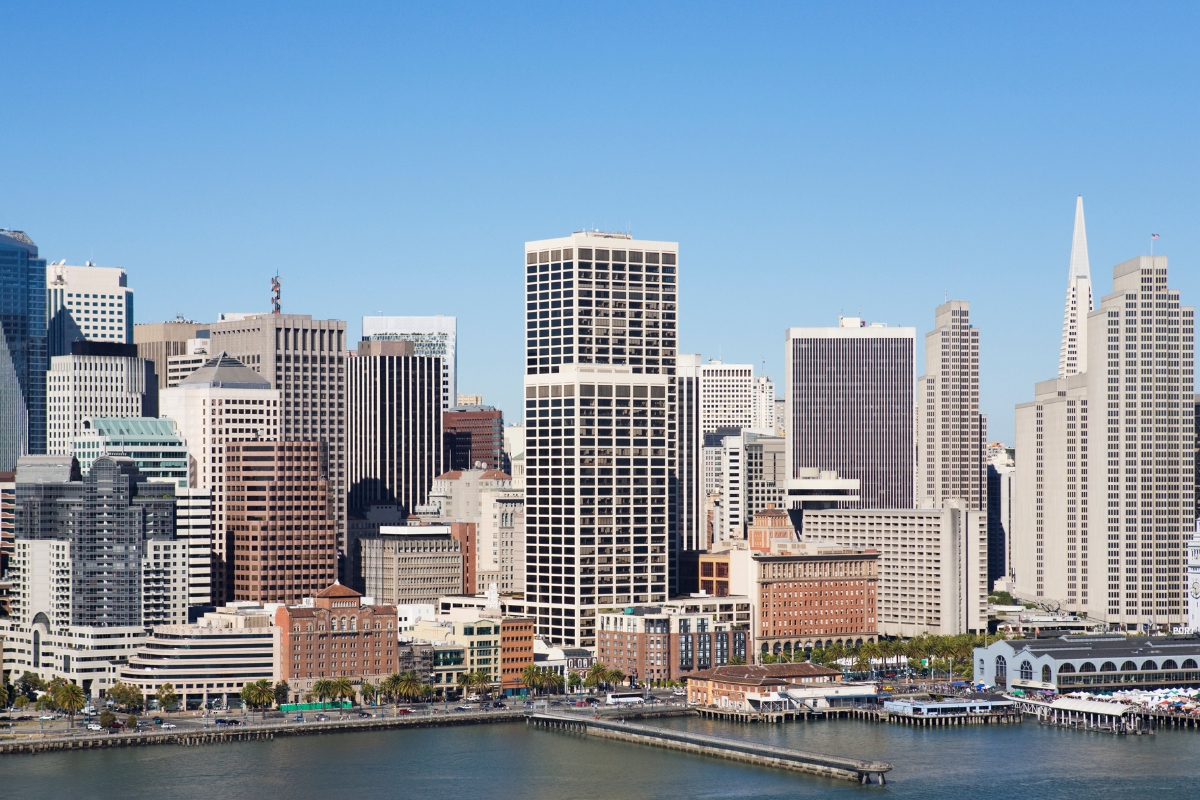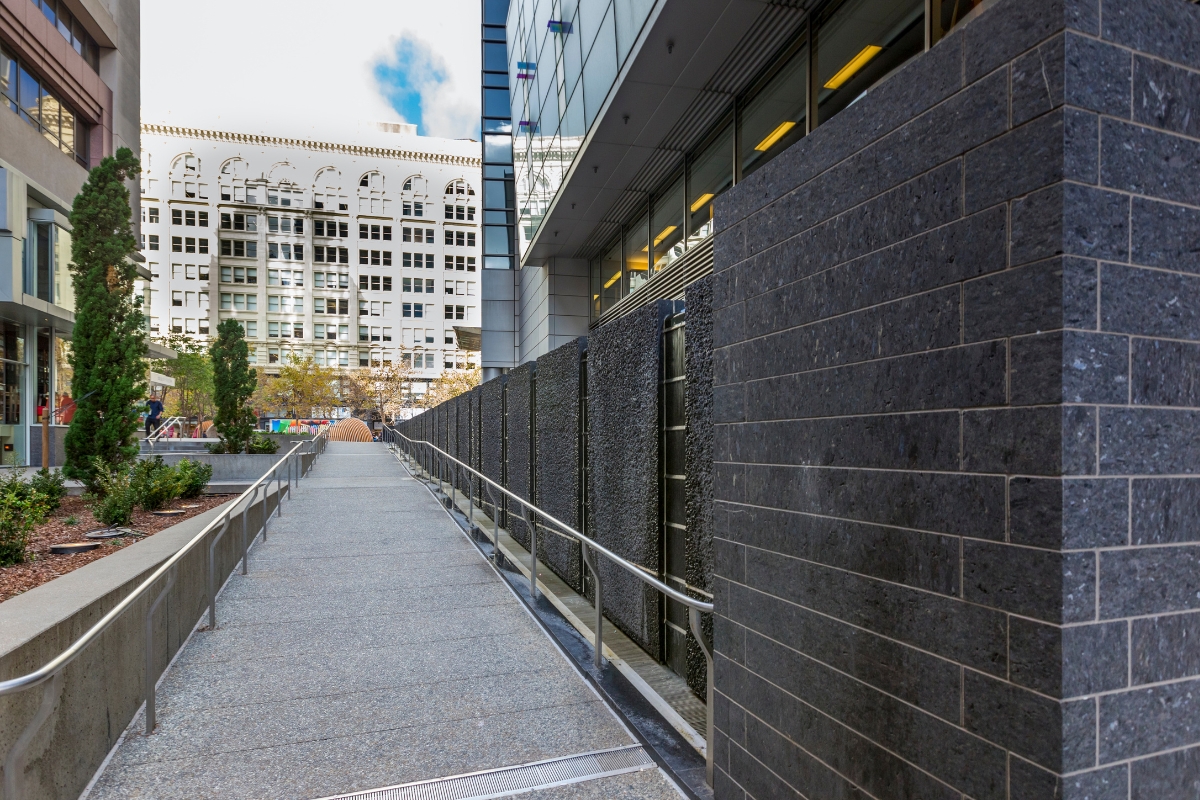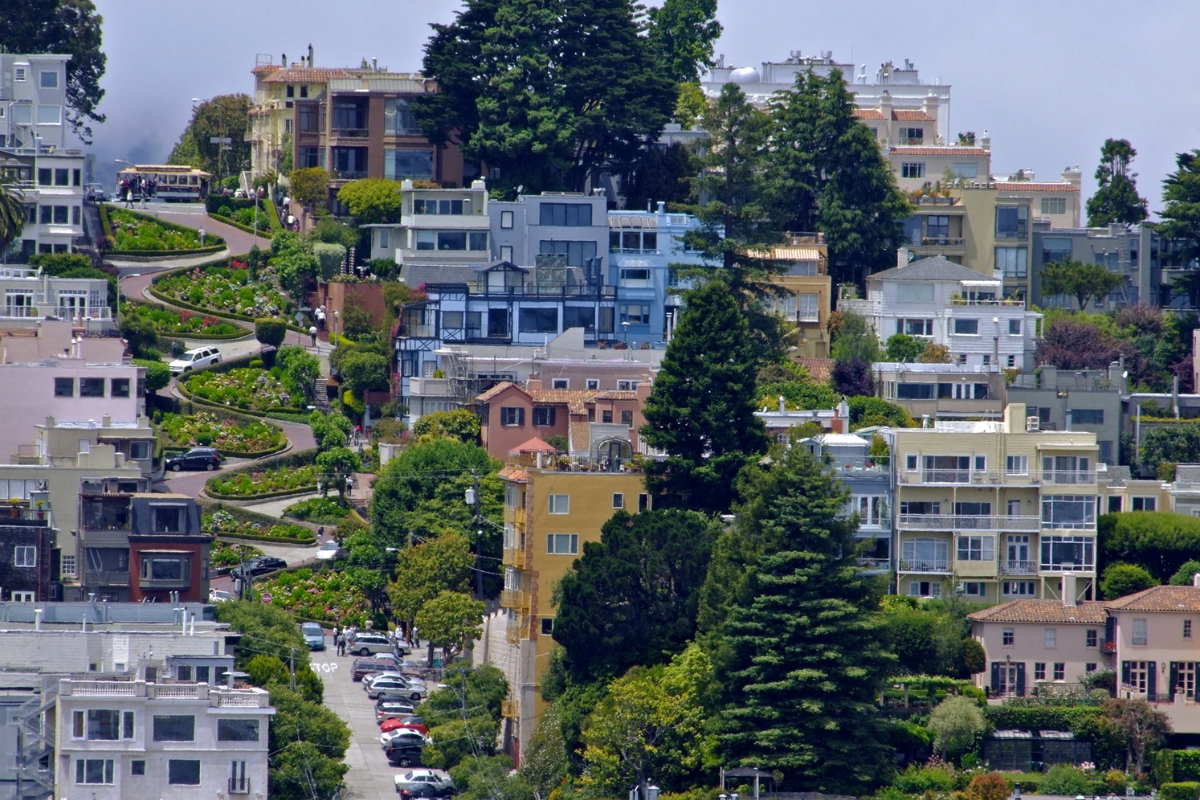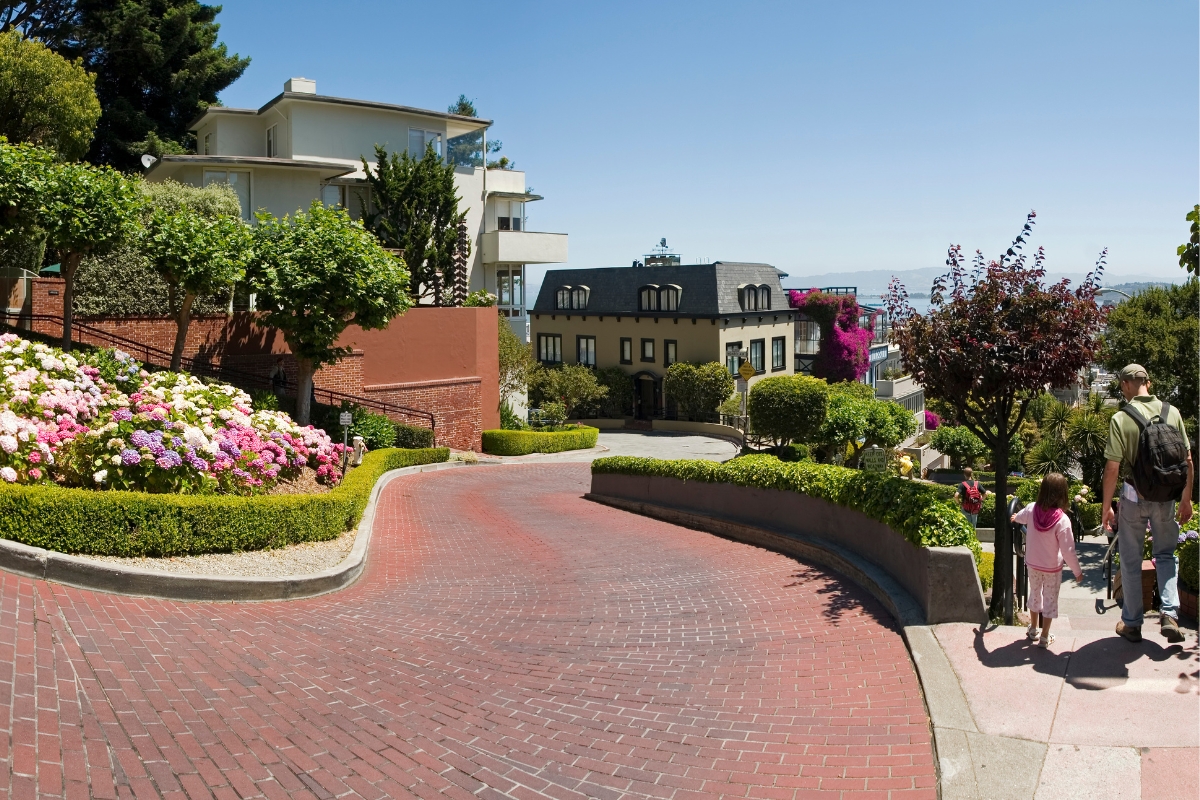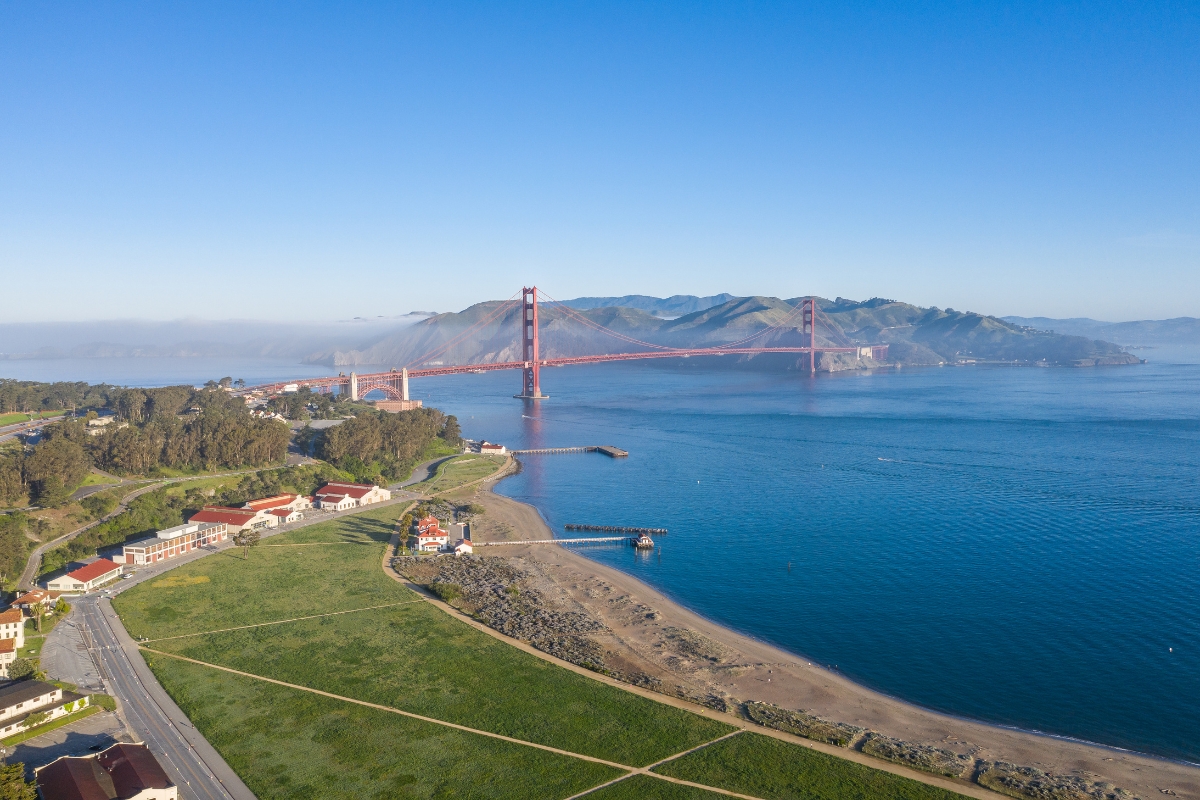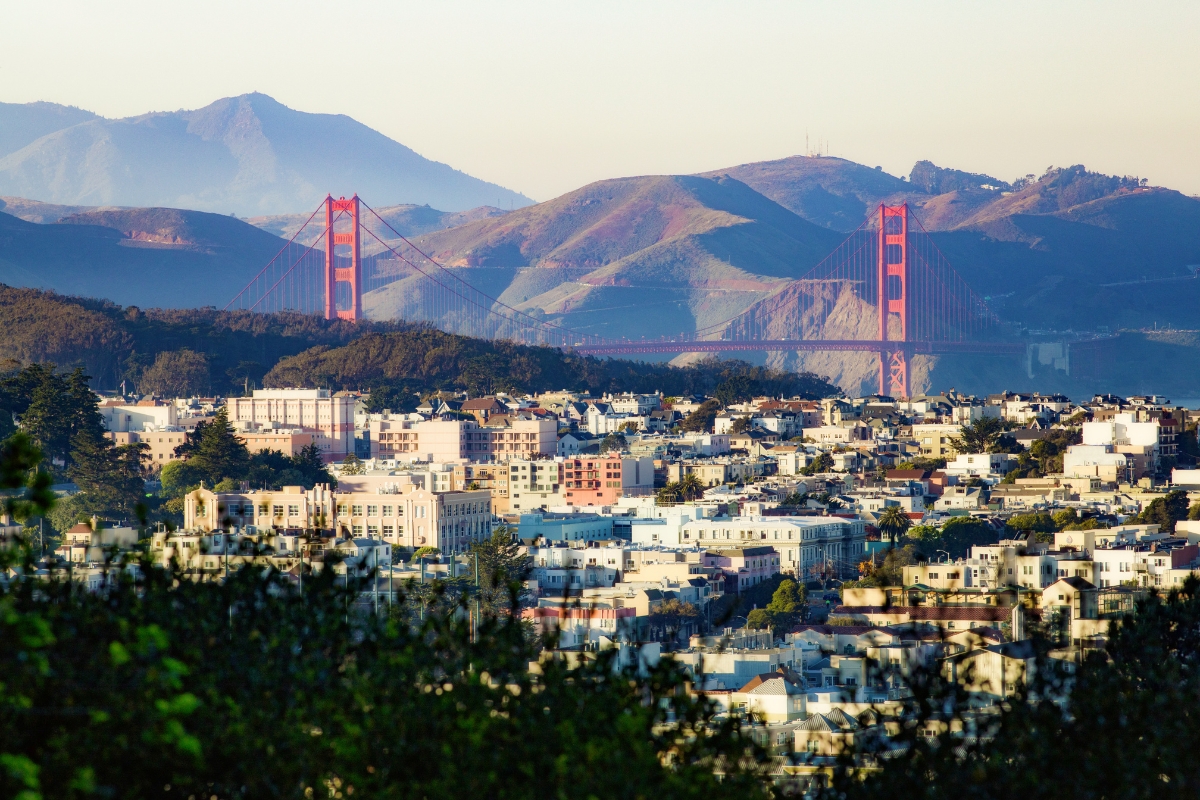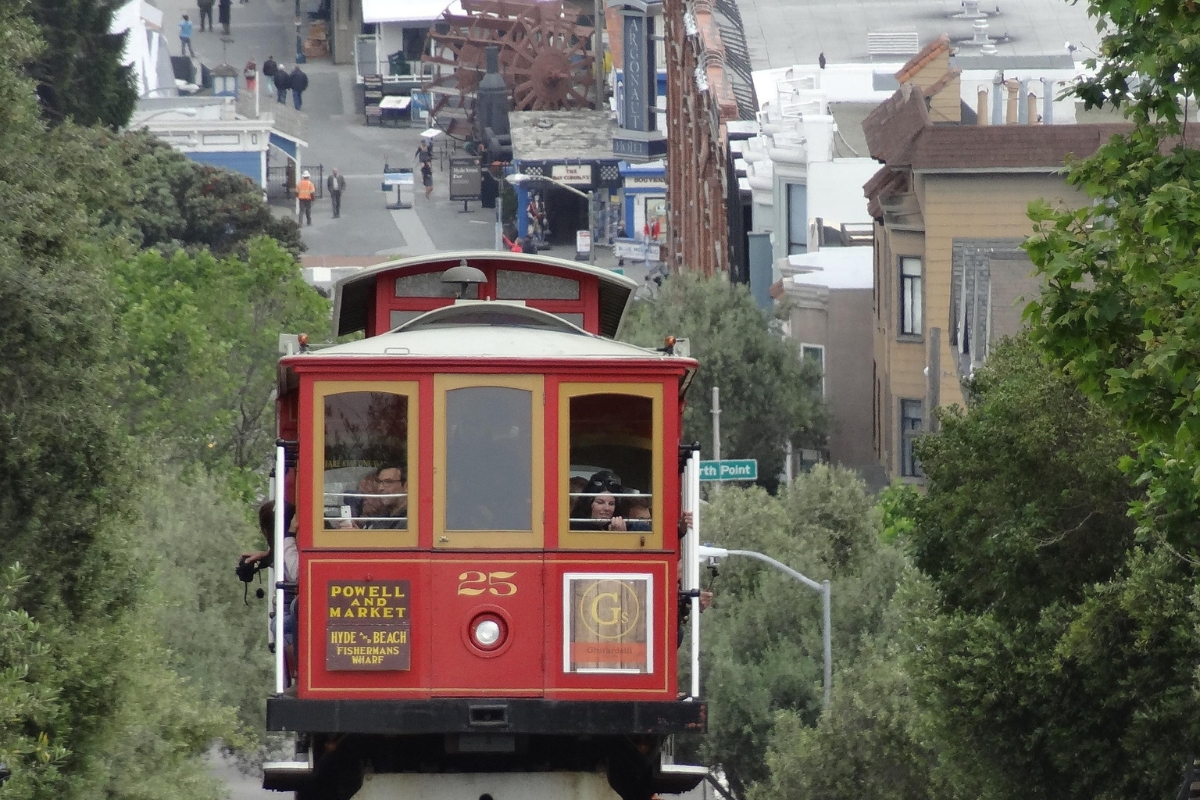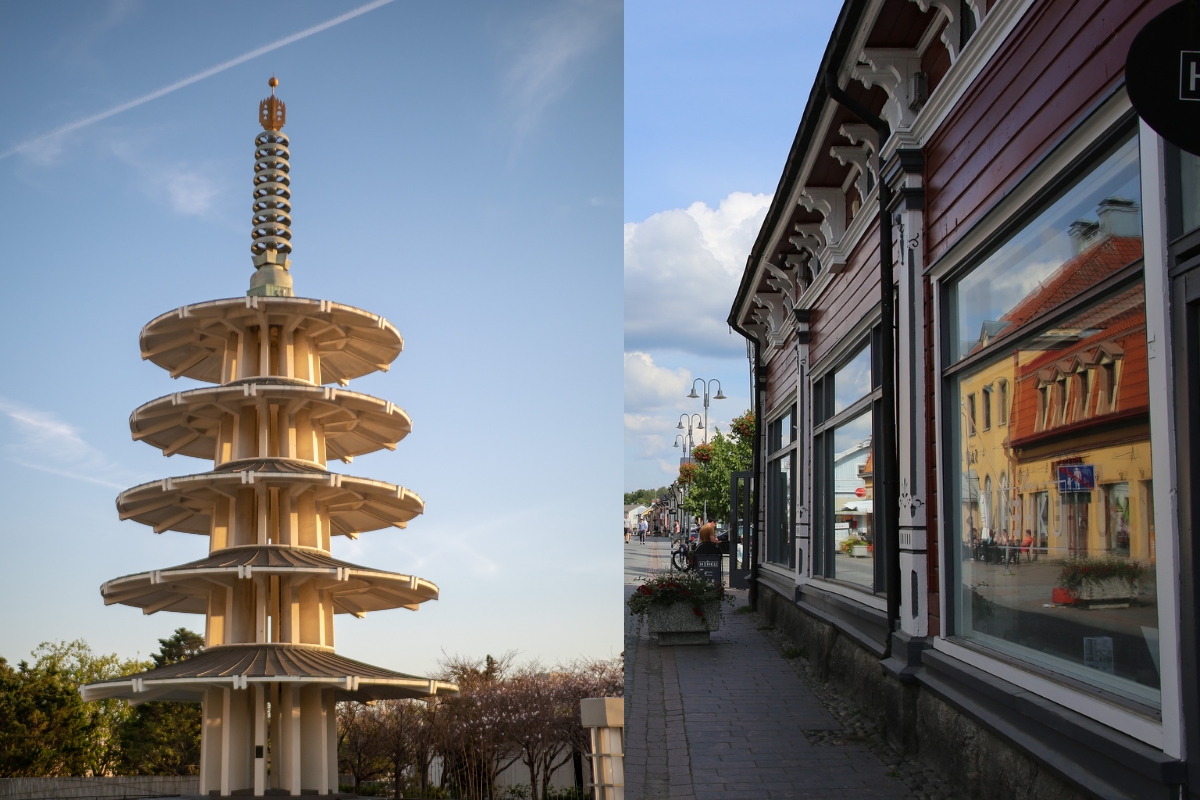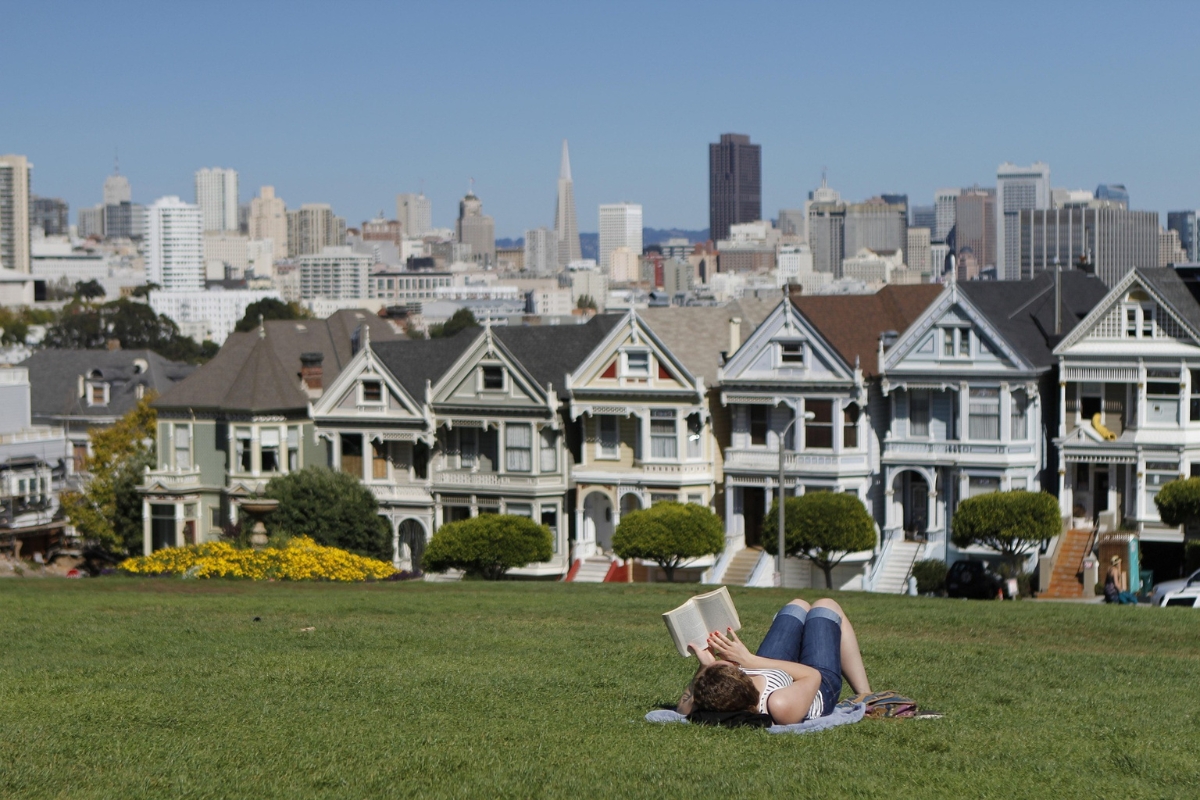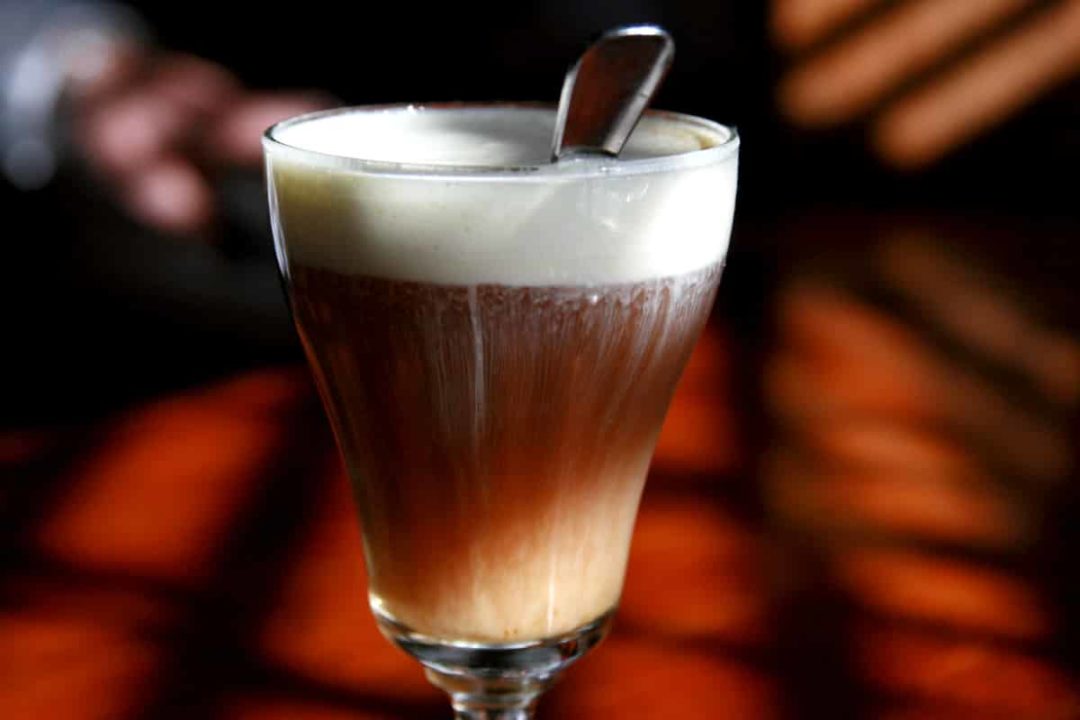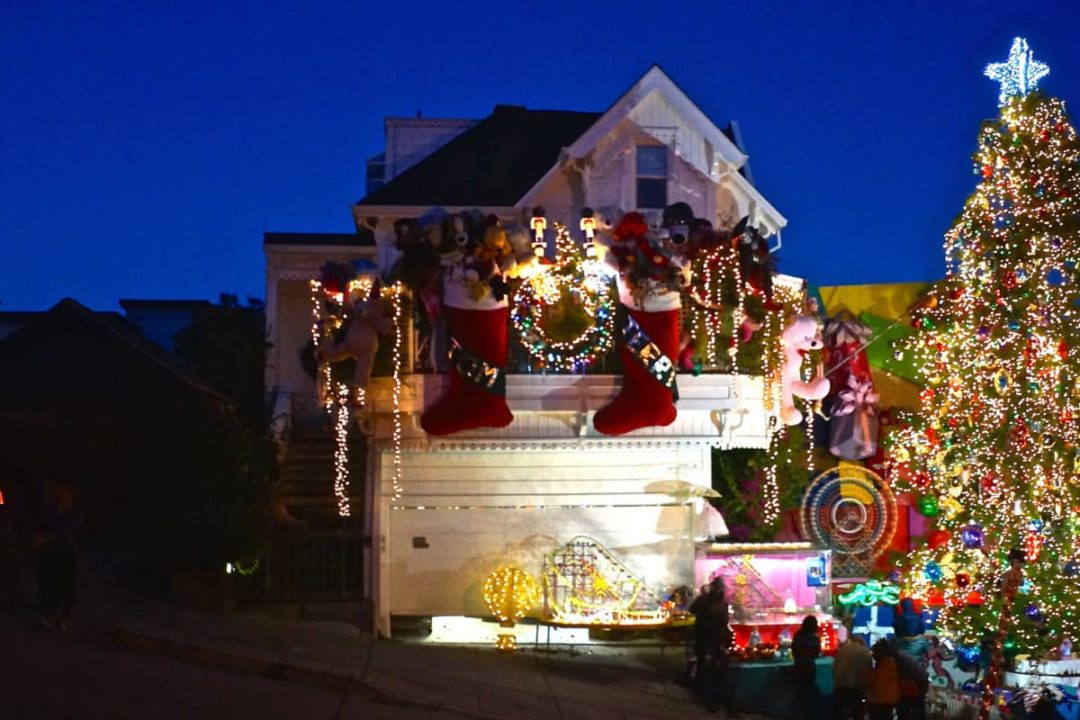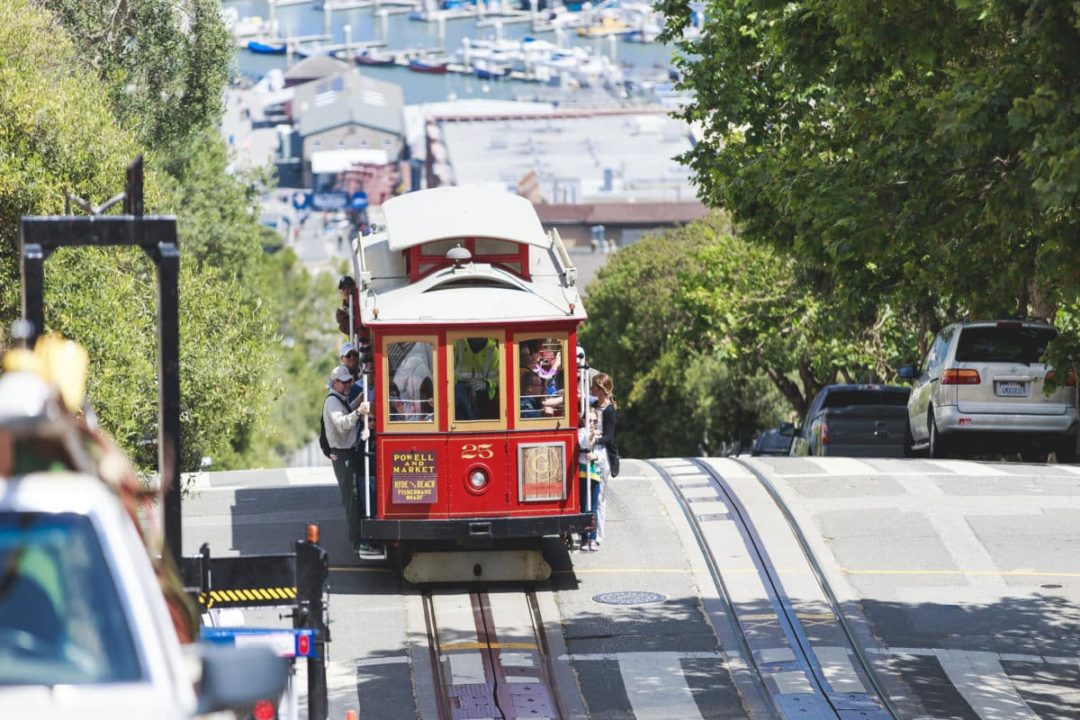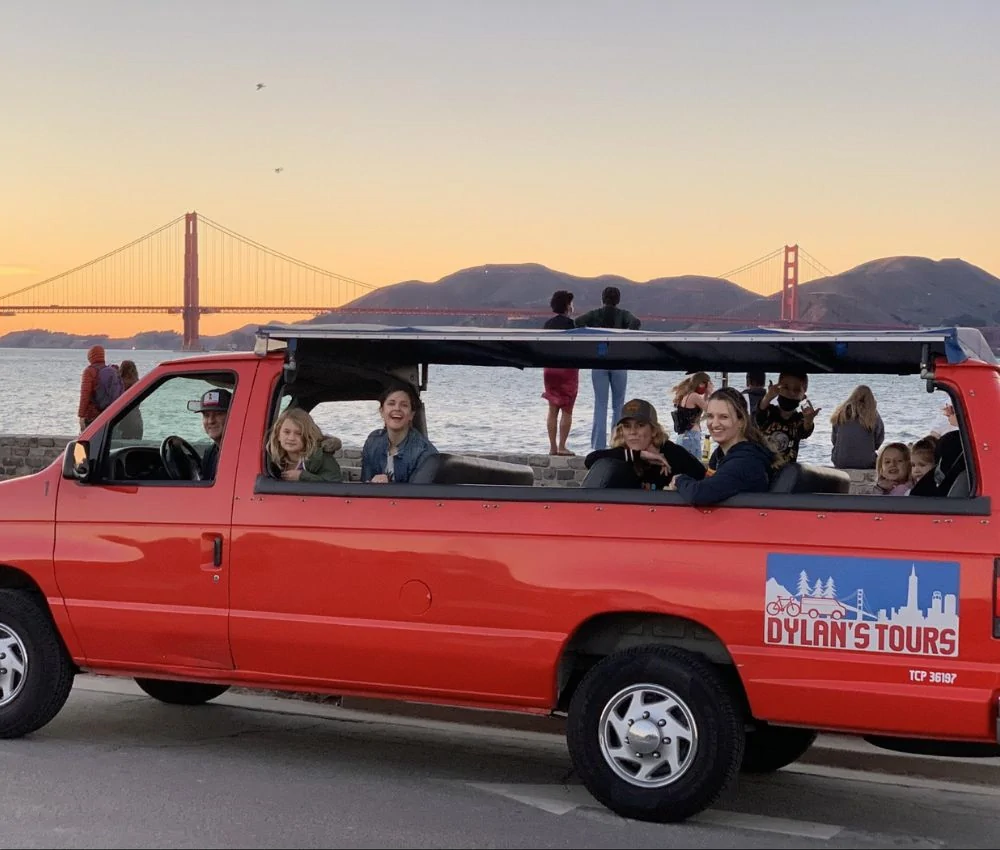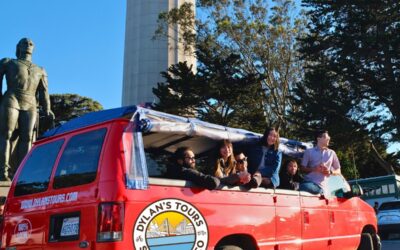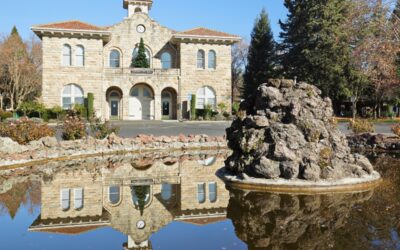Stay in the wrong spot and you might find yourself far from the sights you care about, worrying more about logistics and traffic than necessary. Your home base not only should match your travel style, but should also allow you to truly experience this city the way you’ve always dreamed of. Now is the time to tap into the real San Francisco.
From the pristine and historic Nob Hill to the waterfront charm of the Embarcadero, to the urban park escapes of the Presidio and the cultural treasures of Japantown, each San Francisco neighborhood offers its own personality, price point, and perks. While Fisherman’s Wharf may be ideal for families and sightseeings, others like the Marina are better suited for couples chasing cocktails and city lights—let Dylan’s Tours help you pick the perfect neighborhood to stay in.
In this guide, we’ll break down the best neighborhoods to stay in based on your travel style, budget, and interests—whether you’re here for the food, the views, the culture, or something that’s fun for the whole family.
Let’s find your perfect San Francisco base.
Fisherman’s Wharf – Best for Families, First-Time Visitors, and Sightseeing Access
Fisherman’s Wharf is one of San Francisco’s most iconic and tourist-friendly neighborhoods. With its lively waterfront vibe, street performers, fresh seafood stalls, and postcard views of Alcatraz, it’s a great fit for families, cruise travelers, and first-timers who want to be close to the city’s most popular attractions.
From the sea lions at Pier 39 to the historic ships at Hyde Street Pier, and the hands-on fun of the Exploratorium and Musée Mécanique, this area is packed with things to see and do for people of all ages. It’s especially great for travelers who plan to spend most of their time doing classic SF activities—like eating clam chowder in a sourdough bread bowl, hopping on a cable car, or taking a ferry to Alcatraz—and don’t mind being surrounded by other visitors.
Who It’s Best For:
Families with kids of all ages, first-time tourists eager to check off the city’s top sights, cruise passengers looking for a convenient overnight stay near the piers, and travelers who want to focus their trip around classic San Francisco experiences and attractions.
Where to Stay:
The Wharf is packed with mid-range and family-friendly hotels, many offering views and proximity to the piers. Expect prices between $200–$400 per night.
- Argonaut Hotel – Nautical-themed and upscale, with Golden Gate views and direct access to the waterfront. Housed in a historic brick warehouse, it blends maritime charm with boutique luxury.
- Hotel Zephyr – Fun and funky with an outdoor game yard, ideal for families and groups. Rooms are playfully designed with bold decor, porthole windows, and fire pits in the courtyard.
- Holiday Inn Express & Suites Fisherman’s Wharf – Reliable comfort with a central location. A solid pick for families who want easy access to the piers without breaking the bank.
- Hotel Zoe Fisherman’s Wharf – Chic and contemporary with a Mediterranean-inspired courtyard and on-site seafood restaurant. A great option for couples or style-conscious travelers looking for boutique comfort just a block from the waterfront.
Tips for Getting Around:
- Ride the cable cars or historic streetcars: The Powell-Hyde and Powell-Mason cable car lines start at the Wharf and make for a scenic ride into downtown. The F-line streetcar also connects the Embarcadero and Market Street directly to the neighborhood.
- Hop on a bike or scooter: With flat terrain and scenic waterfront paths, Fisherman’s Wharf is perfect for bike rentals—especially if you’re riding across the Golden Gate Bridge or along Crissy Field.
- Use rideshare for flexibility: Uber and Lyft are widely available and especially useful in the evening if you’re heading to neighborhoods with better dining or nightlife options.
- Skip the car: Parking is limited, expensive, and heavily patrolled, so we strongly advise not renting or bringing a car unless absolutely necessary.
- If you do drive: Be extra cautious. Always hide valuables, lock your vehicle, and never leave anything visible—break-ins can happen even in busy areas.
Pros & Cons
Fisherman’s Wharf is a great choice for travelers who want to be in the heart of San Francisco’s most iconic attractions. It’s extremely walkable, with family-friendly activities around every corner—whether you’re exploring Pier 39, visiting the Aquarium of the Bay, or catching a ferry to Alcatraz.
Everything from historic ships to street performers is just steps from your hotel, making it especially appealing for families with kids or first-time visitors who want easy access to sightseeing without worrying about transit logistics. It’s also ideal for travelers without a car, since parking is limited and public transportation—like cable cars and streetcars—is plentiful and right outside your door.
That said, the Wharf is one of the most tourist-saturated areas in the city, and that comes with trade-offs. It can feel crowded and commercial, especially on weekends or during the summer months, with souvenir shops and chain restaurants lining the streets. If you’re looking for local flavor, diversity, or a more authentic neighborhood vibe, you won’t find it here.
Dining options tend to cater to tourists—think big portions and high prices rather than hidden culinary gems. While the area delivers on convenience and classic sights, it may feel a bit too touristy for travelers who want to dig deeper into the real San Francisco.
The Embarcadero – Best for First-Time Tourists, Food Lovers and Families
If it’s your first trip to San Francisco and you want to feel instantly immersed in the city’s most iconic sights, staying along the Embarcadero is a no-brainer. This vibrant waterfront stretch offers postcard-worthy views of the Bay Bridge, easy access to ferries and public transit, and an unbeatable location next to the famed Ferry Building Marketplace—a food lover’s paradise packed with local vendors, artisanal goods, and some of the city’s best bites.
The Embarcadero is a beautiful, iconic part of San Francisco ideal for travelers who want to explore on foot. You can stroll north toward both Pier 39 and Fisherman’s Wharf or hop on a historic cable car to explore other parts of the city. You can also easily ferry across the bay if you’re looking to explore Tiburon, Sausalito and Marin. The nearby Exploratorium is a hit with curious kids and adults alike, while the views of the bay make even a casual walk feel like a must-do activity.
Who It’s Best For:
The Embarcadero is ideal for first-time visitors, foodies, couples, families and anyone looking for a central, scenic, and easy-to-navigate home base. It’s particularly convenient if you’re looking to do more of the touristy—yet worthwhile—sights including Alcatraz, Pier 39 and Fisherman’s Wharf. These are all great attractions for anyone who’s never been to the city.
Good to know? It’s also within walking distance to Union Square and the Financial District, along with nearby high end shopping.
Where to Stay:
This area leans upscale, with modern hotels offering views and convenience. Average hotel prices range from $300-$500+ per night.
- Hyatt Regency San Francisco – Known for its grand atrium and location steps from transit.
- 1 Hotel San Francisco – A chic, eco-conscious hotel with spa services and bay views.
- Four Seasons Hotel San Francisco at Embarcadero – Known for unmatched views from upper floors, sleek design, and top-tier service.
Tips for Getting Around:
- Muni Metro & BART Access: Embarcadero Station connects you to the entire city (and even to the airport via BART).
- Ferries for Scenic Day Trips: Hop on a ferry to Sausalito, Tiburon, or even Oakland—it’s a fun and scenic way to explore beyond SF.
- Cable Cars & Streetcars: Vintage streetcars and cable cars both run nearby, perfect for sightseeing and snapping pics.
- Walkability: You’re in one of the city’s most walkable areas, so bring comfy shoes and enjoy the bay breeze as you explore.
- We don’t recommend having a car in this neighborhood. If you choose to drive and park somewhere, be sure to put anything visible in the trunk and take your valuables with you.
Pros & Cons:
Ultimately, choose the Embarcadero if you’re looking for a neighborhood that blends scenic beauty with convenience. This waterfront stretch is one of the most walkable areas in San Francisco, perfect for travelers who want to be steps from iconic sights like the Ferry Building, Bay Bridge, and Exploratorium. It’s also a dream for food lovers—with artisan coffee, gourmet grab-and-go, and sit-down waterfront dining all clustered along the promenade.
Spend your morning wandering the Ferry Plaza Farmers Market, grab lunch from local vendors, or enjoy a sunset dinner with sweeping bay views. With BART, Muni streetcars, ferries, and cable cars all nearby, it’s incredibly easy to get around the city without a car, making it ideal for first-time visitors, couples, or anyone who wants an easy, elegant home base.
Now, hotel prices tend to run high, especially at waterfront properties, so it may not suit budget-conscious travelers. On weekends, the area can become crowded with tourists and market-goers, which can detract from the peaceful atmosphere you might be hoping for.
And while it’s full of daytime energy, the Embarcadero winds down early—you won’t find much in the way of nightlife, dive bars, or live music venues here. If you’re the type of traveler who wants to discover hidden cocktail lounges or dine late into the night, you may be better off staying in neighborhoods like North Beach, the Mission, or the Marina and just visiting the Embarcadero by day.
Union Square – Best for Shoppers, Theatre-Goers, and Central Access
Union Square is the beating heart of downtown San Francisco—perfect for travelers who thrive on energy, convenience, and having everything at their fingertips. This vibrant, fast-paced area of San Francisco is the city’s most well-known hub for shopping, theater, and high-end hotels, offering a mix of culture, commerce, and classic city buzz.
Though it has changed since the pandemic and is still getting back to how things used to be, it’s still where you’ll find flagship department stores like Macy’s, Saks Fifth Avenue, and Neiman Marcus, alongside luxury boutiques, trendy brands, and countless restaurants, cafés, and cocktail lounges. Depending on the day, keep an eye out for street festivals and free live concerts in the square.
It’s an especially great choice for travelers who want to explore San Francisco on foot or via public transit. Whether you’re planning to shop ‘til you drop, see a Broadway-style production, hop on a cable car, or simply wander through downtown and neighboring areas like Chinatown, SoMa, or Nob Hill, Union Square puts you at the center of it all.
And with its mix of historic hotels and modern towers, it offers accommodations to suit both classic tastes and contemporary preferences. If you want to be surrounded by action from morning to night, this is a good choice.
Who It’s Best For:
Union Square is perfect for shoppers, theater lovers, and travelers who want a central location with everything nearby. It’s especially well-suited for people who enjoy a downtown, city vibe—where the buzz of streetcars, the glow of marquee lights, and the hum of busy sidewalks create an energetic atmosphere around the clock.
Where to Stay:
Union Square has everything from luxury hotels to budget-friendly chains. Expect rates between $180–$450 per night.
- The Westin St. Francis – A grand, historic hotel overlooking the square. Famous for its iconic glass elevators and timeless lobby, it’s been hosting dignitaries and travelers since 1904.
- Hotel Nikko San Francisco – Sleek and modern with a rooftop pool and Japanese restaurant. It also features a live music lounge and is known for some of the most spacious rooms in Union Square.
- The Marker San Francisco – Stylish and eclectic, close to theaters and nightlife. Expect bold interiors, velvet armchairs, and a touch of artistic flair that sets it apart from chain hotels.
- The Beacon Grand – A revived historic gem with Art Deco glamour and elevated city views. Formerly the Sir Francis Drake, this boutique hotel blends classic San Francisco charm with updated elegance and a rooftop bar that nods to its storied past.
Pros & Cons
Union Square is a great choice for travelers who want to be in the middle of everything. Its central location makes it incredibly convenient, with direct access to BART, Muni Metro, cable cars, and multiple bus lines—making it easy to get just about anywhere in the city.
You’ll find world-class shopping, from high-end boutiques to flagship department stores, and a diverse range of dining options, from trendy rooftop bars, low key pubs, to historic steakhouses. The area is also walkable to major neighborhoods like Chinatown, SoMa, and Nob Hill, and it’s a hub for San Francisco’s theater scene, with major venues just steps away. For visitors who love the urban energy of a downtown city vibe, Union Square puts everything right at your doorstep.
However, Union Square isn’t everyone’s cup of tea. It can feel crowded, loud, and a bit commercial, especially during peak shopping hours or convention season. While it’s lively and convenient, it lacks the neighborhood charm and residential feel of places like the Mission or North Beach. Some nearby blocks—particularly west toward the Tenderloin—can feel gritty or sketchy at night, which may be off-putting to more cautious travelers. If you’re looking for a more local, cozy, or family-oriented experience, Union Square may feel too fast-paced or impersonal.
Tips for Getting Around:
- Transit Hub at Your Doorstep: Powell Street BART Station connects you directly to the airport, the East Bay, and other major transit hubs—ideal for travelers coming in by plane or train.
- Cable Cars and Muni Metro: Historic cable cars and several Muni Metro lines intersect here, making it easy to reach neighborhoods like Fisherman’s Wharf, Nob Hill, and the Embarcadero without needing a car.
- Walkable to Key Areas: You can walk to Chinatown, the Financial District, SoMa, and even Nob Hill—all within 10 to 20 minutes on foot.
- Rideshare Ready: Ubers and Lyfts are fast and frequent, great for getting to less transit-friendly neighborhoods like the Mission, Outer Richmond, or the Presidio.
- Be Cautious at Night: Some nearby blocks—especially west toward the Tenderloin—can feel sketchy after dark, so stick to well-lit streets or grab a rideshare back to your hotel.
- We don’t recommend having a car in this neighborhood. If you choose to drive and park somewhere, be sure to put anything visible in the trunk and take your valuables with you.
Nob Hill – Best for Classic San Francisco Vibes and Luxury Seekers
If you want to stay somewhere that feels like old-school San Francisco, Nob Hill is calling your name. Perched atop one of the city’s famous hills, this historic neighborhood is known for its grand hotels, beautiful mansions, iconic cable cars clanging up and down the streets, and sweeping views over the skyline and bay. It’s as San Francisco as it gets.
It’s the kind of place where you can easily find vintage cocktail bars, restaurants with storied histories and famous patrons, and tucked away urban parks with ornate fountains and manicured greenery. Nob Hill is steeped in elegance, making it ideal for travelers who appreciate architecture, quieter streets, and a more refined, posh atmosphere.
Within one square block, at the center of this neighborhood, you’ll stumble across legendary landmarks that include Grace Cathedral, a mini Notre-Dame of the West; the storied Fairmont Hotel, a symbol of San Francisco luxury and old-world glamour; and the InterContinental Mark Hopkins which is home to the world-renowned Top of the Mark sky lounge.
The neighborhood’s central location means you can walk or take a short ride to Union Square, Chinatown, or North Beach, though you’ll want comfortable shoes—those hills are no joke.
Who It’s Best For:
Luxury travelers, older couples, honeymooners, and history lovers who want a slower-paced, picturesque experience that embodies old-school San Francisco. A love of a classic martini doesn’t hurt either.
Where To Stay:
Nob Hill is home to some of San Francisco’s most iconic hotels with a price range of $250-$450 per night.
- InterContinental Mark Hopkins – Famous for its panoramic views and historic charm. Home to the iconic Top of the Mark sky lounge, it’s a favorite for sunset cocktails with sweeping views of the Bay and skyline.
- Fairmont San Francisco – A luxury landmark that blends grandeur and comfort. This is where presidents, celebrities, and royalty have stayed—complete with elegant ballrooms, a rooftop garden, and timeless SF glamour.
- The Ritz-Carlton San Francisco — Housed in a beautifully restored 1909 neoclassical building, it’s known for its timeless elegance and exceptional service. Guests love its serene courtyard, refined Club Level experience, and walkable location near Nob Hill and Chinatown.
Tips for Getting Around:
- Hop on a cable car: Nob Hill is one of the best places to ride San Francisco’s historic cable cars. They’re not just scenic—they’re practical for getting to Union Square or Fisherman’s Wharf.
- Use rideshares: Ubers and Lyfts are widely available and a smart option if you want to avoid walking uphill after a long day.
- Walking is doable—but be ready for climbs: The neighborhood is walkable, but those hills are real. Flat, comfortable shoes are a must.
- Close to transit lines: Several Muni bus lines run through or near Nob Hill, making it relatively easy to get downtown or to other neighborhoods without a car.
- We don’t recommend having a car in this neighborhood. If you choose to drive and park somewhere, be sure to put anything visible in the trunk and take your valuables with you.
Pros & Cons:
Stay in Nob Hill if you’re drawn to classic San Francisco charm, elegant surroundings, and a touch of old-school glamour. This historic hilltop neighborhood was once home to the city’s elite and still carries that air of refined exclusivity today—with grand hotels like the Fairmont and the InterContinental Mark Hopkins, stately architecture, and cable cars that climb dramatically up its steep streets.
It’s a perfect fit for luxury travelers, older couples, and history buffs who want a calm, polished retreat that’s still within a short cable car ride or Uber to downtown neighborhoods like Union Square, Chinatown, or North Beach. You’ll enjoy sweeping views, quiet evenings, and a feeling of being tucked into one of the most iconic corners of the city.
Do keep in mind that the steep hills, while scenic, make it challenging for those with mobility issues, and walking anywhere—even a few blocks—can feel like a workout. The neighborhood is more residential and refined than lively, with very limited nightlife, entertainment, or kid-friendly attractions, so travelers looking for a buzzing social scene or family-focused amenities may feel underwhelmed.
While there are some great dining options, they tend to lean upscale and quiet—so if you’re craving spontaneous late-night eats or a vibrant street scene, you’re better off basing yourself in more dynamic neighborhoods like the Mission, Marina, or Hayes Valley.
Financial District – Best for Business Travelers and Convenience
The Financial District is much more than just suits, boardrooms and skyscrapers. While it’s undoubtedly the city’s business hub during the weekday rush, it also offers a surprisingly strategic location for travelers who want easy access to some of San Francisco’s top attractions without being in the middle of the tourist swarm.
Sleek office buildings dominate the skyline, but just a few blocks away you’ll find cultural gems like Chinatown, the Ferry Building, and the vibrant dining scene of North Beach. Head just south, and you’re in SoMa (South of Market)—home to the Moscone Center, SFMOMA, and tech giants like Meta and Google.
The Salesforce Tower, San Francisco’s tallest building, anchors the southern edge of the Financial District and is connected to Salesforce Park—a lush, elevated urban garden complete with walking paths, events, and stunning skyline views. It’s a hidden gem for anyone looking to unwind without leaving the city core.
Who It’s Best For:
It’s a great home base for solo travelers, convention-goers, business travelers, solo tourists, digital nomads, and low-key visitors who prioritize location and convenience. The area tends to empty out after business hours, so it’s often more peaceful than other parts of downtown at night.
Where to Stay:
The area offers a combination of both well-known chains and boutique hotels with character that range from $200-$400 per night,
- The Jay, Autograph Collection – A newly renovated luxury hotel with a design-forward vibe, perfect for modern travelers who want comfort with personality.
- Hilton San Francisco Financial District – Convenient, clean, and ideally located next to Chinatown and walking distance to North Beach.
- The Westin St. Francis – Just a few blocks away from the Financial District, this historic hotel offers upscale rooms, great views, and direct access to the shopping and dining of Union Square.
- The Marker San Francisco – Located on the edge of the Tenderloin and Union Square, this bold and eclectic boutique hotel is a good choice for those who want style, creativity, and a short ride or walk to the FiDi.
Tips for Getting Around:
- BART & Muni Metro: Embarcadero and Montgomery Stations are both nearby, giving you fast access to the rest of the city—and even the East Bay and SFO.
- Walking Distance to Key Neighborhoods: Chinatown, North Beach, the Embarcadero, and Union Square are all within a 10–15 minute walk.
- Great for Transit Connections: Ideal if you’re planning day trips or heading to conferences—no need to rent a car.
Rideshare Readily Available: Since it’s a major business area, Ubers and Lyfts are quick and easy to grab, especially on weekdays.
- We don’t recommend having a car in this neighborhood. If you choose to drive and park somewhere, be sure to put anything visible in the trunk and take your valuables with you.
Pros & Cons:
The Financial District is an ideal base for solo travelers, business travelers, and convention-goers who prioritize convenience and proximity over personality. It’s one of the most centrally located neighborhoods in San Francisco, offering quick access to the Embarcadero, Chinatown, North Beach, and even SoMa, where you’ll find the Moscone Center and Salesforce Tower.
If you’re attending a conference, working remotely, or just want to be within walking distance of major transit hubs like BART, it’s hard to beat. It also offers a sense of calm after hours, which some travelers appreciate—especially those who prefer quiet evenings or need to get work done. Hotels here range from sleek business chains to newer boutique options like The Jay.
But while the location is incredibly convenient, the Financial District lacks that classic San Francisco charm you’ll find in neighborhoods like North Beach, the Mission, or Nob Hill. Once the workday ends, many office buildings empty out and the streets can feel a little sterile or lifeless, especially in the evenings and on weekends.
Late-night dining is minimal, and nightlife is practically nonexistent, so if you’re looking to grab a spontaneous dinner at 9 p.m. or bar-hop without a Lyft, you’ll be better off staying elsewhere. In short, if your vision of San Francisco includes culture, street-level energy, quirky cafes, or historic character, the Financial District might feel more like a launching pad than a destination.
Marina District (Lombard Street) – Best for Budget Travelers, Road Trippers, and Nightlife Lovers
If you’re driving into San Francisco or looking for an affordable stay with decent parking, waterfront views, and a buzzing bar and nightlife scene, the Marina District is your go-to. Centered along Lombard Street, this neighborhood is known for its cluster of motels, boutique hotels, and wide streets with actual parking—a rare luxury in the city. What sets the Marina apart is its blend of laid-back charm and high-energy nights.
Mornings start with coastal walks at Crissy Field, coffee runs on Chestnut Street, and views of the Golden Gate Bridge. But when the sun goes down, the area lights up with one of the city’s best bar-hopping and nightlife scenes. From casual pubs to cocktail lounges and under-the-radar hot spots, the Marina draws a social, young crowd—especially on weekends.
Who It’s Best For:
Budget-conscious travelers, friend groups, road trippers, young couples, and anyone looking for a built-in nightlife scene with walkable options. It’s also great for people who want to be near iconic sights like the Palace of Fine Arts and the Golden Gate Bridge.
Where to Stay:
Lombard Street and nearby blocks offer a range of motels and boutique hotels perfect for those driving in or watching their budget. The typical price per night in this neighborhood is $120–$250 per night.
- Kimpton Alton Hotel – A stylish, retro-modern boutique hotel with personality and on-site dining. Just a short hop to both the Marina and Fisherman’s Wharf.
- Marina Motel – A hidden gem with charming, ivy-covered courtyards and free parking, perfect for road trippers.
- Cow Hollow Inn – Clean and no-frills, with a prime location and complimentary parking.
- Lombard Plaza Motel – Affordable, accessible, and walking distance to bars and the bay.
Tips for Getting Around:
- Driving is Easy: One of the few SF neighborhoods where having a car is actually convenient—and often free to park.
- Muni Access is Basic: A few bus lines service the area, but you’ll likely need transfers to reach downtown or other neighborhoods.
- Bike and Scooter Friendly: The flat landscape makes this a perfect place to rent a bike or e-scooter and cruise the waterfront.
- Uber/Lyft for Everything Else: Rideshare is the fastest way to get downtown, to the Mission, or home from a night out.
Pros & Cons:
This neighborhood is a smart pick for travelers with cars—many hotels offer free or easy parking, a rarity in San Francisco. It’s also a great option for budget-conscious visitors who want clean, comfortable lodging without sacrificing location. And if you’re in the mood for a fun night out, the Marina is one of the city’s top spots for bar-hopping and lively nightlife, especially among the 20- and 30-something crowd.
Think bustling patios, buzzy cocktail bars, and a social, weekend-ready vibe. Bonus: You’re just minutes from scenic landmarks like the Golden Gate Bridge, Crissy Field, and Marina Green.
That said, if you’re looking for the cultural depth and edge that define San Francisco’s character, this may not be your perfect fit. The Marina is more polished and residential, and it doesn’t offer the same diversity or layered history you’d find in neighborhoods like the Mission or North Beach. Public transit is limited, so without a car, it can feel a bit disconnected from the rest of the city.
The Presidio – Best for Nature Lovers, Active Families and Scenic Escapes
Tucked into the northwest corner of San Francisco, The Presidio is where the city meets urban serenity. Once a military post, this massive green space is now a national park and one of the most beautiful and peaceful places to stay in the city. Think towering eucalyptus trees, coastal trails, and panoramic views of the Golden Gate Bridge—all within city limits.
Staying here feels like a retreat from the bustling urban environment that characterizes other parts of the city. It’s perfect for travelers who want to wake up to birdsong, go hiking before breakfast, or spend an afternoon exploring Presidio Tunnel Tops—one of San Francisco’s newest parks, the Walt Disney Family Museum, or scenic overlooks like Inspiration Point. With limited hotels and a slower pace, this is the spot for travelers who value quiet over convenience.
Who It’s Best For:
Nature lovers, scenic seekers, families with kids who enjoy hiking and spending time outdoors, photographers looking to shoot panoramic views of the bay area and beyond, and anyone craving peace and fresh air.
Where to Stay:
The Presidio has a couple of boutique, park-run lodges that blend history and comfort with the average price per night ranging between $250 – $400.
- Lodge at the Presidio – A beautifully restored military barracks with views of the bridge. Guests love the complimentary wine and cheese hour, fire pits, and unbeatable access to hiking trails right outside the door.
- Inn at the Presidio – Cozy and charming, with fireplaces and a front porch feel. This intimate lodge offers a quiet, tucked-away experience with historic charm and a true “national park meets boutique hotel” vibe.
Pros & Cons:
The Presidio offers a peaceful, nature-centric alternative to the urban energy of most San Francisco neighborhoods. Nestled within a national park at the city’s edge, it’s an ideal stay for families, photographers, hikers, or anyone craving a quiet, scenic retreat. Guests can explore wooded trails, coastal overlooks, and iconic views of the Golden Gate Bridge—all without leaving the city.
Staying at boutique lodges means you’re literally waking up inside a national park, with fresh air, historic architecture, and plenty of room to roam. It’s also one of the few areas in San Francisco where free or convenient parking is widely available, making it a great choice for road trippers or anyone planning to drive.
That said, the Presidio isn’t for everyone. Its location on the city’s northwest edge means it’s far from downtown and not well connected by public transit. If you’re on foot or relying on buses and trains, getting in and out of the park—especially at night—can be inconvenient.
Dining options are limited, and the overall vibe is tranquil and residential, not buzzing with nightlife or cultural events. If your ideal San Francisco experience includes walkable access to shopping, diverse neighborhoods, or vibrant street life, the Presidio might feel a bit too isolated.
Tips for Getting Around:
- Bring a Car (or rent one): The Presidio is spread out, and driving is the easiest way to reach trailheads, viewpoints, and restaurants outside the park.
- Use the Presidio GO Shuttle: A free weekday shuttle connects the Presidio to downtown SF and nearby neighborhoods like the Marina and Cow Hollow.
- Plan for Rideshare: Uber and Lyft work well here, but wait times can be longer than in central neighborhoods—especially at night.
- Great for Biking: If you’re up for some hills, bike paths through the park offer a scenic and active way to get around.
Japantown – Best for Foodies and Culture Seekers
Small but packed with personality, Japantown is one of only three remaining neighborhoods of its kind in the U.S.—and it’s a gem for travelers who love to explore local culture through food, history, and quiet charm. It’s ideal for those who love Japanese culture particularly.
Centered around Peace Plaza and the Japan Center Mall, this neighborhood offers an authentic taste of Japanese-American culture, from sushi bars and ramen shops to specialty bookstores, gift shops, and the beloved Kabuki Spa.
It’s a slower-paced, less touristy part of San Francisco that feels like a secret worth discovering. While it may not be close to the city’s biggest attractions, its unique atmosphere makes it a perfect base for travelers who want to eat well, explore at their own pace, and stay somewhere that feels local and unique to San Francisco.
That said, it’s also close to the Fillmore District which is San Francisco’s historic hub for live jazz music, which still hosts regular performances at venues like The Boom Boom Room and Sheba Piano Lounge—giving you access to nightlife with serious cultural roots. This part of the city also offers a selection of upscale boutique shopping, as well as eateries, cafes and bars that aren’t tied to Japanese culture.
Who It’s Best For:
Foodies, culture lovers, couples, those with a particular affinity to Japanese culture, and solo travelers looking for a low-key stay.
Where to Stay:
Japantown has a couple of stylish mid-range hotels within walking distance of the action that range around $180–$300 per night.
- Hotel Kabuki – A stylish, Japanese-inspired hotel with a tranquil garden and on-site bar
- Kimpton Hotel Enso – Boutique vibes with modern comforts and easy walkability
Tips for Getting Around:
- Use Muni Buses: Several Muni lines (including the 38-Geary) run through or near Japantown, making it easy to get downtown or to the ocean.
- Walk to Fillmore Street: Just a few blocks away, Fillmore offers more restaurants, boutiques, and cafes with a livelier vibe.
- Rideshare is Easy: Uber and Lyft are reliable here and great for getting to areas like the Marina, Union Square, or the Embarcadero.
- No Car Needed: Parking is tight, and the neighborhood is very walkable—perfect for exploring on foot and using public transit to venture out.
Pros & Cons
Stay in Japantown if you’re looking for a hidden gem in San Francisco and appreciate authentic cuisine, cultural immersion, and a peaceful atmosphere. You’ll be just steps away from incredible Japanese restaurants—from ramen joints and sushi counters to mochi shops and sake bars—as well as specialty bookstores, gift shops, and the iconic Peace Plaza.
However, while it’s unique to explore on its own, it’s not walkable to major landmarks like the Embarcadero, Golden Gate Park, or Fisherman’s Wharf. You’ll likely need to rely on Muni buses, rideshares, or e-bikes to explore the rest of the city. And while there’s energy during cultural festivals like the Cherry Blossom Festival, the neighborhood is generally quiet at night, with only a handful of low-key bars or lounges.
It also has a residential feel, so if you’re looking for a bustling, nightlife-heavy scene or crave the gritty charm of neighborhoods like the Mission or North Beach, this may not be your vibe. But if you’re after great food, authentic local culture, and the occasional night of live jazz, Japantown—paired with the Fillmore—offers a thoughtful and often-overlooked place to stay.
Hotels vs. Airbnbs in San Francisco: What’s Better for Your Trip?
Once you’ve landed in the right neighborhood, there’s still one big decision left: hotel or Airbnb? Both come with their own vibe, their own set of pros and cons, and depending on how you like to travel, one might suit you way better than the other.
Hotels are the classic choice, and for good reason. If this is your first time in San Francisco—or you just want a smooth, no-hiccups kind of trip—hotels offer a level of ease that’s hard to beat. You’ve got 24/7 front desk support, daily housekeeping, on-site dining, and maybe even a spa or rooftop bar.
Hotels are also usually located in prime areas like the Embarcadero, Nob Hill, or the Financial District, which means you’re steps away from public transit, waterfront views, and iconic attractions. There’s a certain comfort in knowing exactly what you’re getting—and if you’re someone who likes a concierge to help book your Alcatraz tour or dinner reservation, hotels are definitely the move.
That said, the convenience does come at a cost. Hotels in San Francisco aren’t cheap, especially if you’re staying anywhere near the water or in a luxury spot with amenities. And if you’re traveling with a family or group, hotel rooms can start to feel a little cramped.
On the flip side, Airbnb gives you a totally different experience—more like living in the city than just visiting it. It’s a great way to tap into local life and stay in neighborhoods that don’t have many hotels, like the Mission, Noe Valley, or the Inner Sunset. These are the kinds of places where you’ll find charming Edwardian flats, sunny backyard patios, and real-deal neighborhood bakeries around the corner.
For longer stays, families, or travelers who want a kitchen and a little more breathing room, Airbnb can be a total game-changer. Plus, you get to experience San Francisco the way locals do, in the quieter, more character-filled corners of the city.
But Airbnb isn’t without its quirks. You might be dealing with confusing check-in instructions, high cleaning fees, or hosts with very specific house rules. And not every place lives up to the photos. San Francisco also has strict short-term rental laws, so there’s always a small risk that your booking could be canceled last-minute if the host isn’t following regulations. Plus, unlike hotels, there’s no front desk to call if something goes wrong.
If you’re the type who wants to drop your bags and walk straight into the action, a hotel in the Embarcadero or Nob Hill is a good move. If you’re more about slow mornings, local cafes, and pretending you’re a San Franciscan for a few days, an Airbnb in a neighborhood like Hayes Valley or Cole Valley might be more your speed.
